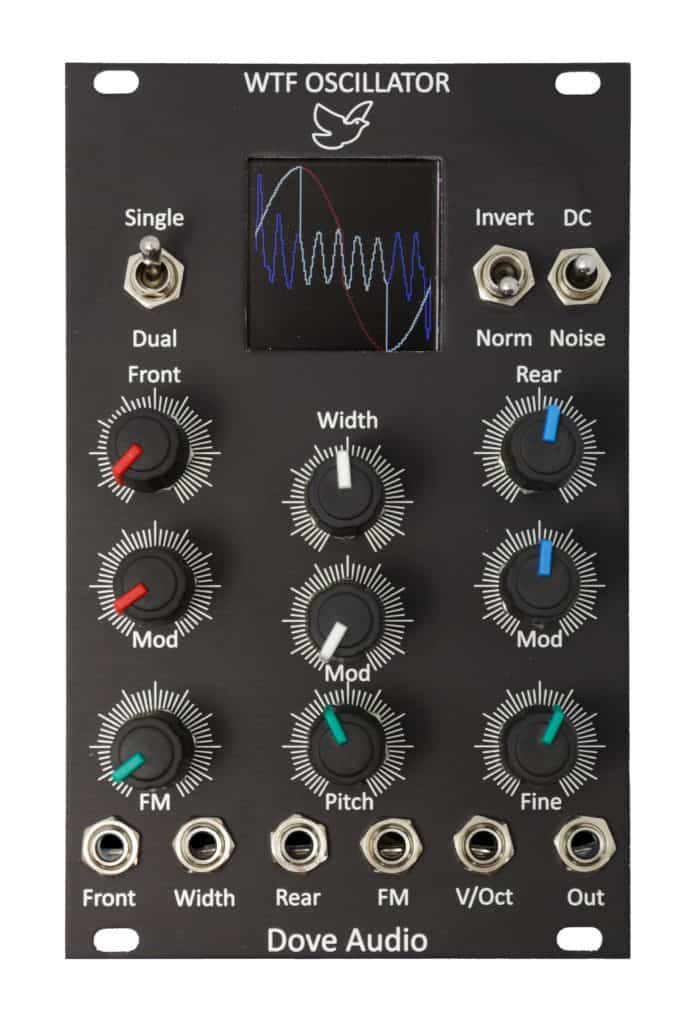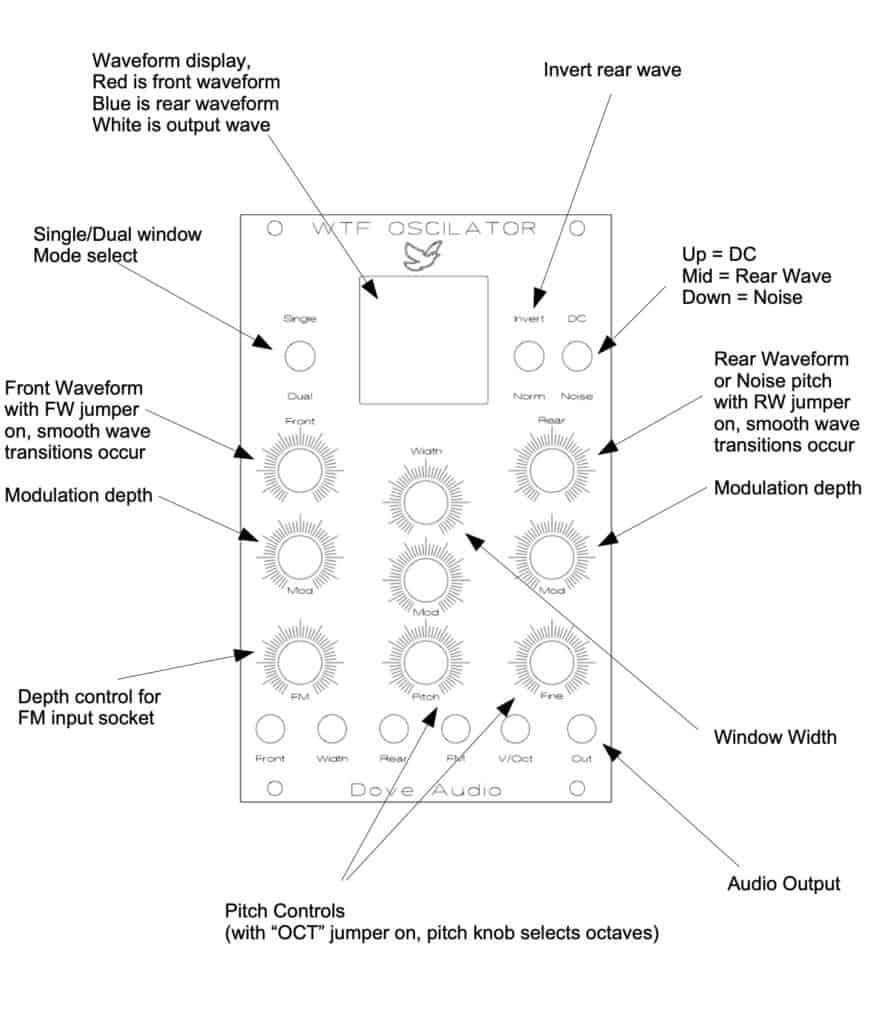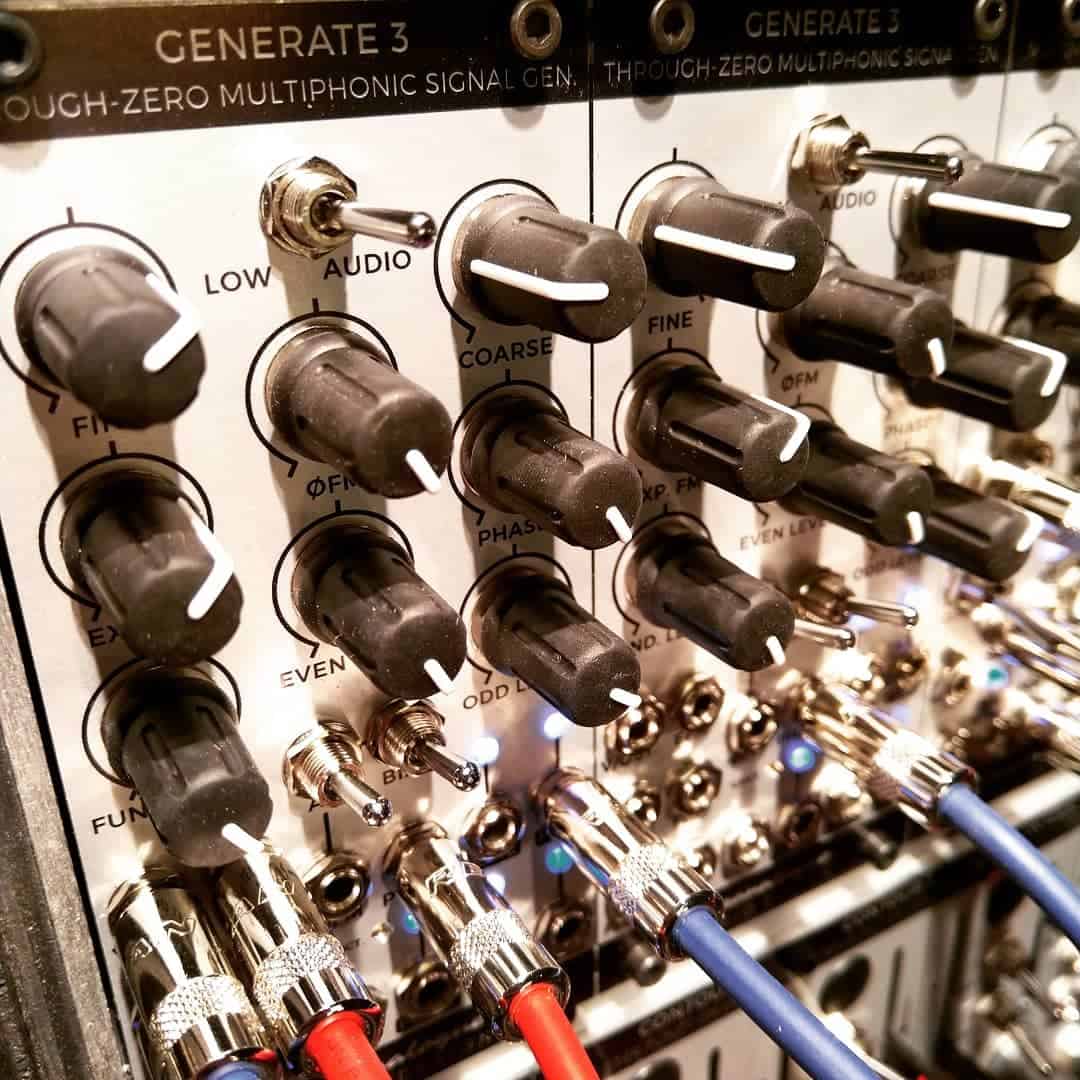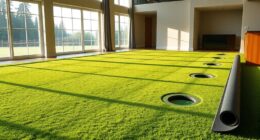WTF Oscillator by Dove Audio Review
Creative oscillators are a trend this year. Not to be outdone, Dove Audio is bringing two wavetable oscillators to the market, through Kickstarter campaigns: the WTF Oscillator and the Waveplane Oscillator. While the latter, a 6-dimensional wavetable oscillator is still in development, the WTF OSCILLATOR became available in early 2019.
Original Concept
WTF stands for Window Transform Function – although the other acronym resolution you may think of would fittingly express my first reaction to the module’s originality, in both concept and performance.
The WTF Oscillator is available in both Eurorack and MU format. Today we’re having a look at the Eurorack version, a 16hp module equipped with and a comprehensive 1-inch color LCD display.
Sound
One fact that is true with all of these new complex oscillators, is that you could, in theory, achieve the same results with several other modules in a complex patch – that would be more expensive, more space hungry, and impossibly hard to keep in tune. With this oscillator, the operation is simple and effortless – thanks in part to its clear layout.
What does Window Transform Function (WTF) mean?
Imagine two perfectly synced oscillators, generating two different waveforms of the same frequency. Now imagine that at some fixed point within every cycle, you’d switch from one waveform to another, resulting in a final waveform that is a sequential combination of the two. Actually, there’s not just one switching point, but two (switching forth and then back) or four (switching forth and back and forth and back again – all within every cycle).
Now imagine the switching points are not that fixed, but their timing can be CV modulated. And the form of both source waves can be modulated as well. That is what the WTF Oscillator is all about.

The term “Window” comes from the visual representation that synchronized switching lets you peek at the “rear” waveform through an open window in the “front” one, as the hereabove graph illustrates. That graphical representation is so much clearer than words, that you’ll find it animated in real time on the module’s LCD screen – an enormous help.
First hands-on impressions
I was understandably excited when I finally got the module for which I had pledged on Kickstarter. I mounted it right away and started playing with it. Overall, the general build feels sturdy. The controls are as intuitive as expected. The knobs’ size, grip, and stiffness feel excellent.
The wavetable provides a continuous morphing through a vast assortment of waveforms. You’ll probably want to hit it with several modulators – LFOs and the like – to take full advantage of the possibilities. It would have been nice to be able to use it as an LFO – some crazy LFO it would be! But it doesn’t get that slow, and would probably be too grainy for that anyway.
Due to its moderate refresh rate, the display can’t keep up with very fast modulations. That’s not a problem, really. Just don’t rely too much on the display when modulating at audio rates.
Sonic character
Now, as digital modules go, this one leans on the low-fi side. In fact (I may be wrong, but) I don’t see anything ressembling a microprocessor on the circuit board. My guess is the memory registers are read in the crudest way – more on this later. I would call it “digilogue” rather than “digital” circuitry. It is certainly great to some tastes, but personally, I found the limitations it implies a bit of disappointment.
First of all, the resolution is good enough for medium- to high-pitched tones, but too low for bass sounds. Oh, I make basses with it anyway, because how could I resist? But while original, I find them a bit weak. Compared to analog oscillators, the WTF lacks punch in lower octaves.
Then, with slow modulations, you can hear steps in the waveform morphing and window width variation. Although this not uncommon among Eurorack wavetable modules, finer steps or some interpolation would have been nice.
Finally, I find myself wishing for a bit of smoothing (a.k.a. crossfading) around the window’s edges. This too is a matter of taste, obviously, but the kinds of sound the wavetable provides make me want to create smoothly evolving tones, rather than harsh ones. Alas, as the window’s edges swipe across complex waveforms, sharp angles in the resulting wave tend to come and go somewhat abruptly.
All these aspects may be due to the fact that this is not a chipped module: Even though wavetables are inherently digital, there is no digital nicety like interpolation, anti-aliasing, or algorithms of any kind, apparently. In fact, it seems the desired pitch is achieved by crudely synchronizing the D-A converter to the variable rate at which memory is read. This indeed would not require a microprocessor, as a simple onboard analog oscillator could serve as a clock. And since the WTF’s tuning tends to drift while heating up (though very little compared to other oscillators), this may very well be the case.
Advantages of such a design are that the aliasing artifacts are always harmonic to the note, resulting in a gritty yet musical grain – and you’ll hear no muffling or Nyquist artifacts at high pitches. There’s a plain quality to the sound all the way from low mids to high frequencies.
User interface & Usability
Controls
The available table is the same for both waveforms, however, it is quite extensive. In addition to the choice of single vs. dual window, it is also possible to reverse the polarity of one of the waveforms or replace it with a very 8-bit digital noise. In that case, the corresponding waveform knob becomes a control to the noise generator’s clock, thus affecting its spectral band.
The various knobs control Front Waveform (parsing the wavetable), Rear Waveform (idem), and Window Width. Each parameter is controllable both manually and via CV. Attenuators are provided for all CV inputs – a much-appreciated convenience, and color coding makes the panel very comprehensive.

From this limited but well-picked set of controls arises an impressive array of tonal possibilities. There are a few forgivable omissions: there’s no sync input, and the FM is, as usual, not thru-zero. But at least there is FM, which extends the sonic palette considerably.

Rating: Four Out of Five Stars
All in all, the WTF’s character is consistent across all settings, though a bit weak in the lowest pitches. It reacts to settings and modulations predictably, yet yields original and inspiring results. Dove Audio hit the perfect balance between creative potential and simplicity. It’s a fun module.
PROS:
- Original and fun
- Clear and intuitive
- Extensive wavetable
- Sturdy build
CONS:
- Perceptible modulation steps
- Weak bass










